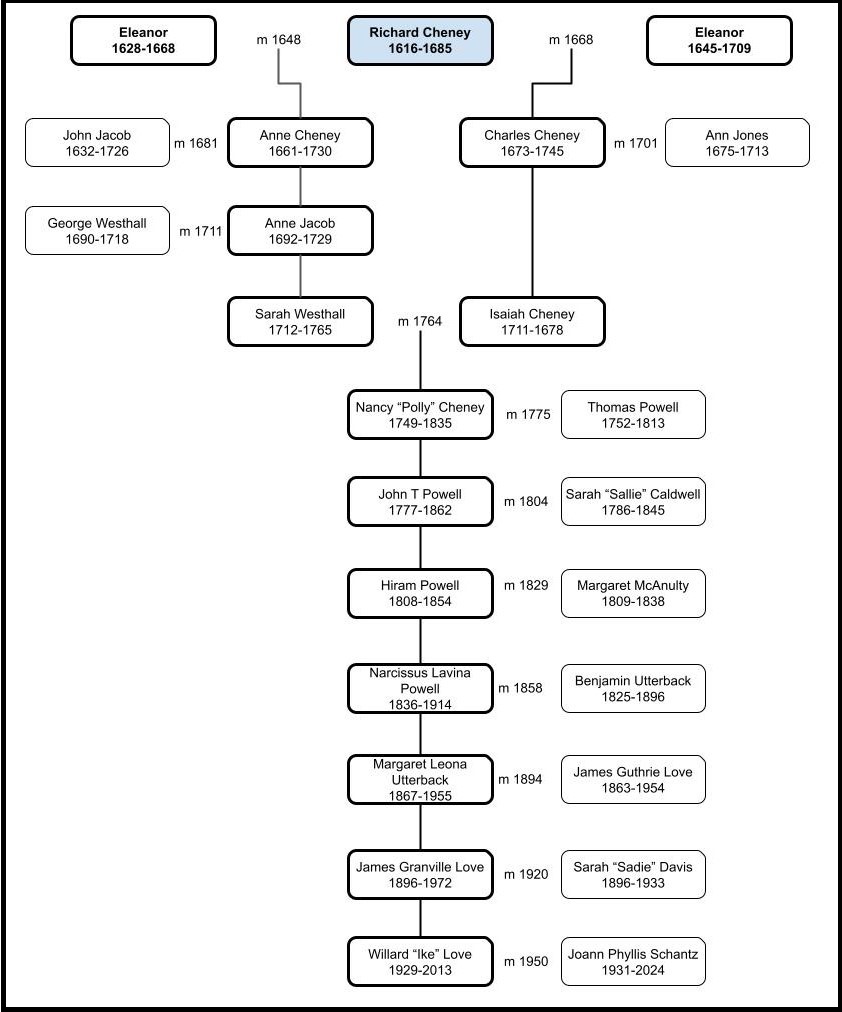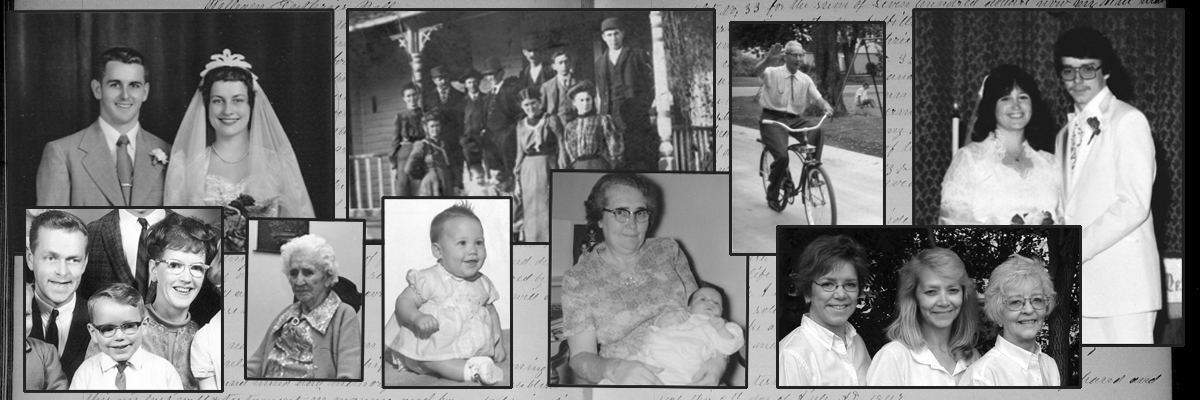I find it interesting to investigate our “firsts.” For example, who was the first of Willard Dean “Ike” Love’s European ancestors to arrive in North America? To try to find an answer to this question, I followed sources and trails, trees and histories, wills, and birth records as far as I could reasonably go along many branches of the family tree. Because there are a lot of assumptions in family history, sometimes a branch on a tree is really just hanging by a thread. The relationships might be shaky. You find yourself scratching your head and saying, “Well, I see that so-and-so is listed as the child of Herkamer and Mavis but why do we believe this is true?” For this task, I have tried to stay with Ike’s most straight-forward ancestral line.
My current understanding is that one of the earliest of Ike’s direct ancestors to make the journey from Europe to North America was Richard Cheney (1616-1685), Ike’s 7th AND 8th great-grandfather. Richard is said to have been born in Middlesex, England. He is along the ancestral line from Ike’s paternal grandmother, Margaret Leona Utterback (1867-1955), the wife of James Guthrie Love (1863-1954). There are a long line of ancestors between Richard, born in England, and Ike, born in Louisa County, Iowa.
According to the family histories and sources available from that time period, Richard Cheney was born in England around 1616 and made his way to North America around 1650, most likely with his wife Charity (surname unknown). Family histories claim his oldest child was born around 1649 in the South River Hundred of Anne Arundel County, Maryland. The official land records placed Richard there in 1658.
English Migration
Once the eastern seaboard of what is now the USA opened up with royal colonies and charters granted by the King of England, English immigrants moved to North America seeking opportunity and, in some cases, freedom from religious persecution. Maryland was purchased from Yaocomico Indians in 1634. The indigenous peoples did not have a concept of exclusive land use and ownership which, of course, continued to lead to conflict and misunderstandings between the two groups. Maryland was granted by charter to Cecil Calvert in 1634 with the expectation that English Catholics, persecuted by the Church of England, could experience religious tolerance. Just as there were religious wars in England around that time, religious groups in Maryland conflicted. In 1650, Puritans who had moved from Virginia to Maryland ousted the local colonial government and set up a new government that prohibited Catholicism and Anglicanism. The revolt did not last. In 1658, the Calvert family regained control and enacted the Toleration Act. By 1688, King William III of England revoked the charter and declared Maryland as a royal colony.
Richard’s Arrival in Maryland
Richard first arrived in Anne Arundel County, Maryland around 1650 coming either directly from England or perhaps made his way up from Virginia. Which one is not completely clear. It is also not clear if he married first wife, Charity, before he left England or once he was in North America. Richard and Charity had four children prior to her death in Anne Arundel County on 24 August 1668. He remarried very soon afterward to Eleanor, most likely the widow of James Pindall, later in 1668. Richard and Eleanor had seven children.

Our direct ancestors include TWO of Richard’s children. Richard and his first wife had a daughter, Anne (1661-1730) married to John Jacob (1632- 1726). Richard and his second wife had a son, Charles (1673-1745), married to Ann Jones (1675- 1713). Anne’s granddaughter, Sarah Westhall, married Charles’ son, Isaiah Cheney. The couple were 1st cousins, once removed.

Richard had most likely journeyed to Maryland seeking his fortune and the opportunity to purchase land and profit from Maryland’s vast natural resources. In Anne Arundel County the main crop was tobacco. He and his family were members of the Westminster Parish, Anglican Church of England, and later the All Hallows Parish. The All Hallows’ Church is listed on the National Register of Historic Places and the parish is still active as part of the Episcopal Diocese of Maryland.
Once Richard was in Maryland, he got to work building land wealth. Richard became one of the largest landowners in the South River Hundred. He acquired “Cheney’s Neck” with 110 acres, “Cheney’s Resolution” with 400 acres, “Cheney’s Hazard” with 100 acres, “Cheney’s Rest” with 300 acres and “Cheney’s Purchase” with 100 acres. That is a total of 1,100 acres. Unfortunately, that land has not been passed along to our branch of the family.
Richard died around 1685 and the will he had created ten years earlier (in 1675) specifically named his children: Richard, Thomas, Charles, Eliza, Mary, and Ann. Since he died ten years after the will was created, five of his younger children were not mentioned in the will but were added on at the bottom. His wife Eleanor died in 1709. Richard, Charity, and Eleanor were buried in the All Hallows Church Cemetery.
But Wait – Why are Eleanor’s Parents Not Listed as the First??
Well, there is some uncertainty about Eleanor. Is Pindall her maiden surname name or her married surname? When and where was she born? These questions lead to a whole lot of “Unverified” tags in the information for Eleanor in my records. I hope to learn more in the future.
So, for today, Richard Cheney holds the place as Ike’s First Ancestor in North America. I continue to research and find new information so Richard could be knocked off this pedestal if more solid sources emerge about other ancestors or relationships. As always, this is my current understanding.
If you would like more information or need detail about my sources, please contact me at renee@reneecue.com.

